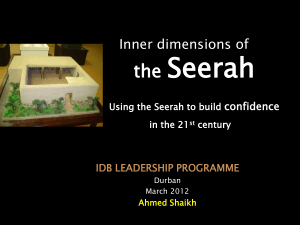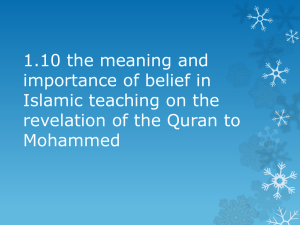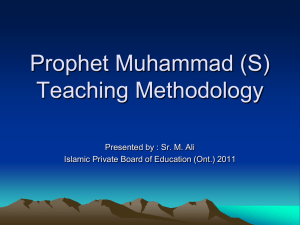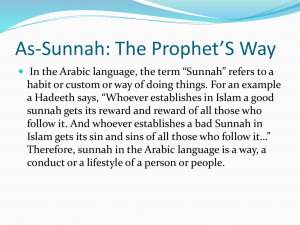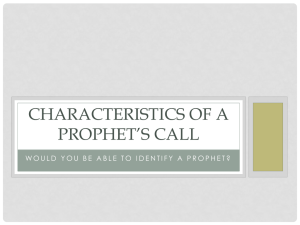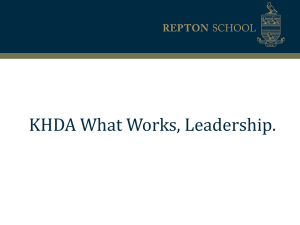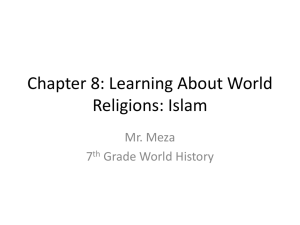Understanding Sunnah: Definition, Classification, and Legal Value
advertisement
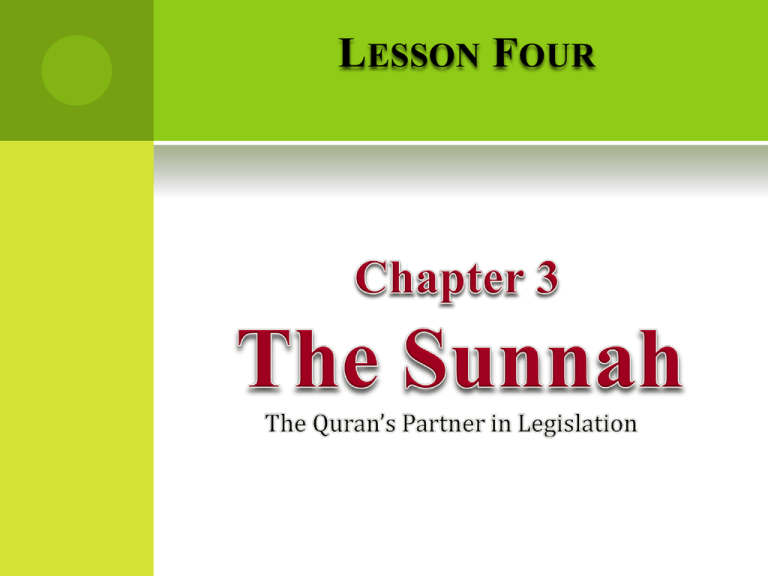
LESSON FOUR D EFINITION Literally, Sunnah means a clear path or a beaten track الطريقة المتبعةbut it is also used to imply normative practice, or an established course of conduct. A sunnah may be a good example or a bad example, and it may be set by an individual, a sect or a community. The opposite of sunnah is بدعة, or innovation, which is characterized by ;lack of precedent and continuity with the past. According to al-Shafi’i’s interpretation, which also represents the view of the majority, the word ‘hikmah’ in this context means the Sunnah of the Prophet. To the uluma of usul al-fiqh, Sunnah refers to a source of the Shariah and a legal proof next to the Quran. To the uluma of fiqh, ‘Sunnah’ primarily refers to a shar’i value which falls under the general category of mandub. To the uluma of hadeeth, Sunnah includes all that is narrated from the Prophet, his words, acts, and tacit approvals, whether before or after the beginning of his prophetic mission, regardless of whether it may contain a ruling of the Shariah or not. H ADEETH Literally, means a narrative, communication or news consisting of the factual account of an event. Hadeeth differs from Sunnah in that hadeeth is a narration of the conduct of the Prophet whereas Sunnah is the example or the law that is deduced from it. hadeeth in this sense is the vehicle or the carrier of Sunnah, The terms خبرand أثرhave often been used as alternatives to hadeeth. Literally, khabar means ‘news or report’, and athar, ‘impression, or impact’. The word khabar' in the phrase 'khabar al-wahid' خبر الواحد for example, means a solitary Hadith. حديث اآلحاد The majority of uluma have used hadeeth, khabar and athar synonymously, whereas others have distinguished khabar from athar. The majority of the uluma have upheld عمل الصحابىthe precedent of the Companions as one of the transmitted (naqli) proofs. According to al-Shafi’i, the Sunnah, coming direct from the Prophet in the form of hadeeth through a reliable chain of narrators, is a source of law irrespective of whether it was accepted by the community or not. He emphasized the authority of the hadeeth from the Prophet in preference to the opinion or practice of the Companion. Even if it is a solitary Hadith. P ROOF -VALUE ()حجية السنة OF S UNNAH The uluma are unanimous on the point that Sunnah is a source of Shariah and that in its rulings with regard to halal and haram, it stands on the same footing as the Quran. The Prophet’s acts and teachings were meant to establish a rule of Shariah constitute a binding proof. The proof of authenticity of hadeeth may be definitive ()قطعى, or it may amount to a preferable conjecture ( ;)الظن الراجحin either case, the Sunnah commands obedience of the mukallaf. All the rulings of the Prophet, especially those which correspond with the Quran and confirm its contents, constitute binding law. The Companions have reached a consensus on this point: both during the lifetime of the Prophet and following his demise, they eagerly obeyed the Prophet’s instructions and followed his examples regardless of whether his commands or prohibitions originated in the Quran or otherwise. II. C LASSIFICATION AND VALUE : (A) Two of the most commonly accepted criteria for such classifications are the subject-matter )المتنof Sunnah and the manner of its transmission ()االسناد. The Sunnah is divided into three types, namely verbal ()قولية, actual ( )فعليةand approvales ()تقريرية. The verbal Sunnah consist of sayings of the Prophet on any subject, such as the hadeeth; the actual Sunnah consists of the Prophet’s deeds and instructions; the tacitly approved Sunnah consists of the acts and sayings of the Companions which came to the knowledge of the Prophet and of which he approved. The tacit approval may be concluded from his silence and lack of disapproval, or from his express approval and verbal confirmation. The sayings of Companions such as ‘we used to do such and such during the lifetime of the Prophet’ constitute a part of Sunnah تقريريةonly if the subject is such that it could not have failed to attract the attention of the Prophet. Non-legal Sunnah ( )غير تشريعيةmainly consists of the natural activities of the Prophet ( )االفعال الجبليةsuch as the manner in which he ate, slept dressed and other such activities as do not seek to constitute a part of the Shariah. Sunnah relating to specialized or technical knowledge, such as medicine, commerce and agriculture, is held to be peripheral ثانويةto the main function of the Prophetic mission and is therefore not a part of the Shariah. As for the acts and sayings of the Prophet that related to particular circumstances such as the strategy of war, including devices that misled the enemy forces, etc. these are considered to be situational and not part of the Shariah. There are certain matters which are peculiar to the person of the Prophet so that his example concerning them does not constitute general law, such as polygamy above the limit of four, marriage without a dowery, prohibition of remarriage of the widows of the Prophet, connected fasting ()صوم الوصال and the fact that the Prophet admitted the testimony of خزيمة بن ثابتas legal proof. The rules of Shariah concerning these matters are as stated in the Quran, and remain the legal norm for the generality of Muslims. T HE LEGAL S UNNAH ()السنة التشريعية The legal Sunnah ( )السنة التشريعيةincorporates the rules and principles of Shariah. The variety of Sunnah may be divided into three types, namely the Sunnah which the Prophet laid down in his capacities as Messenger of God, as the head of state or imam, or in his capacity as a judge. (1) In his capacity as Messenger of God, the Prophet has laid down rules which are, complementary to the Quran, but also established rules on which the Quran is silent. In this capacity, the Sunnah may consist of a clarification of the ambiguous ( )مجملparts of the Quran or specifying and qualifying the general and the absolute contents of the Quran. If the ambiguous of the Quran is known to be obligatory, the explanatory Sunnah will carry the same value. Alternatively, the Sunnah may provide a clear indication as to whether a particular rule it prescribes is wajib, mandub, or merely permissible. An act may require the belated performance ( )القضاءof a wajib or a mandub, and as such its value would correspond to that of its prompt performance ()االداء. If a Prophetic act is intended as a means of seeking the pleasure of God, then it is classified as مندوبand according to a variant view as واجب. 2- SUNNAH IN HIS CAPACITY AS AN IMAM All the rulings of Sunnah which originate from the Prophet in his capacity as imam or head of state, such as the distribution and expenditure of public funds, decisions pertaining to military strategy and war, appointment of state officials, distribution of booty, signing of treaties, etc., partake of the legal Sunnah which does not constitute general legislation (tashri’ ‘amm). Sunnah if this type may not be practiced by individuals without obtaining the permission of competent government authorities first. 3-S UNNAH IN HIS CAPACITY AS A JUDG Sunnah which originates from the Prophet in his capacity as a judge in particular disputes usually consists of two parts: the part which relates to claims, evidence and factual proof, and the judgment which is issued as a result. The first part is situational and does not constitute general law, where the second part lays down general law, however, that it does not bind the individual directly, and no one may act upon it without the prior authorization of a competent judge. Since the Prophet himself acted in a judicial capacity, the rules that he has enacted must therefore be implemented by the office of القاضى. To distinguish the legal from non-legal Sunnah, it is necessary for the mujtahid to determine the original purpose and context in which a particular ruling of the Sunnah has been issued and whether it was designed to establish a general rule of law. That explains why there is sometimes juristic disagreement even with the presence of the hadeeth. Ex. a Hadith on the reclamation of barren land which reads, 'whoever reclaims barren land becomes its owner.[46. Abu Dawud] . The ulema have differed as to whether the Prophet uttered this Hadith in his prophetic capacity or in his capacity as head of state. II.I Q URAN AND S UNNAH D ISTINGUISHED The Prophet clearly expressed the concern that nothing of his own Sunnah be confused with the text of the Quran. This was the main reason why he discouraged his Companions, at the early stage of his mission from reducing the Sunnah into writing lest it be confused with the Quran. The Companions used to verify instances of doubt concerning the text of the Quran with the Prophet himself, who would often clarify them through clear instruction. This manner of verification is, however, unknown with regard to the Sunnah. The entire text of the Quran has come down to us through continuous testimony (tawatur) whereas the Sunnah has for the most part been narrated and transmitted in the form of solitary, or احاد, reports. Only a small portion of the Sunnah has been transmitted in the form of متواتر. Disagreement over the Sunnah extends not only to questions of interpretation but also to authenticity and proof. II.2 T HE P RIORITY OF THE Q URAN OVER THE S UNNAH The jurist must resort to the Sunnah only when he fails to find any guidance in the Quran. Should there be a clear text in the Quran, it must be followed and be given priority over any ruling of the Sunnah. The Quran wholly consists of manifest revelation (wahy zahir) whereas the Sunnah mainly consists of internal revelation (inspiration)(wahy batin) and is largely transmitted in the words of the narrators themselves. If a conflict is seen to exist between the Quran and Sunnah, they must be reconciled as much as possible and both should be retained. If this is not possible, the Sunnah in question is likely to be of doubtful authenticity and must therefore give way to the Quran. No genuine conflict is known to exist between the mutawatir hadeeth and the Quran. The fact that the Sunnah explains and determines the precise meaning of the Quran means that the Quran is more dependent on the Sunnah than the Sunnah is on the Quran. . According to the majority opinion, before implementing a Quranic rule one must resort to the Sunnah and ascertain that the ruling in question has not been qualified in any way or given an interpretation on which the text of the Quran is not self-evident. In all cases where the Sunnah specifies or qualifies the general or the absolute terms of the Quran, the Sunnah in effect explains and interprets the Quran. In no instances is the Quran abandoned in favour of the Sunnah. ) ( السنة قاضية على القران The word qadiyah (arbite) in the expression ) (السنة قاضية على القرانmeans mubayyinah (explanatory) and does not imply the priority of the Sunnah over the Quran. The correct conclusion drawn from passages from the Quran such as the verse in surat al-Nahl ِّ َ( َوأَ ْن َز ْلنَا إِلَ ْيك16:44) ون َ س َما نُ ِّز َل إِلَ ْي ِه ْم َولَ َعلَّ ُه ْم يَتَفَ َّك ُر ِ الذ ْك َر لِتُبَيِّ َن ِللنَّا where the Prophet is addressed, that the Sunnah is explanatory of the Quran, and is subordinate to it. II.3 I S S UNNAH AN I NDEPENDENT S OURCE ? The Sunnah may consist of rules that merely confirm and reiterate the Quran, in which case the rules concerned originate in the Quran and are merely confirmed by the Sunnah. A substantial part of the Sunnah is, in fact, of this variety: all hadeeth pertaining to the five pillars of the faith and other such matters like the rights of one’s parents, respect for the property of others, and hadeeth which regulate homicide, theft and false testimony, etc., basically reaffirm the Quranic principles on these subjects. The Sunnah may consist of an explanation or clarification of the Quran; it may clarify the ambivalent ( )المجملof the Quran, qualify absolute statements, or specify the general terms of the Quran. The Sunnah also qualifies the absolute ( )المطلقof the Quran. The Sunnah may consist of rulings on which the Quran is silent, This variety of Sunnah, referred to as السنة المؤسسة, or ‘founding Sunnah’, neither confirms nor opposes the Quran, and its contents cannot be traced back to the Holy Book. It is only this variety of Sunnah that lies at the centre of the debate as to whether or not the Sunnah is an independent source of law. There is some disagreement among jurists as to whether the Sunnah, or this last variety of it at any rate, constitutes an independent source of Shariah. In his capacity as Messenger of God, the Prophet has introduced laws, some of which originate in the Quran while others do not. But all Prophetic legislations originate from divine authority. The Sunnah and the Quran are of the same provenance, and all must be upheld and obeyed. The majority explain that some of the rulings of the Sunnah consist of analogies with the Quran. The Quran is indeed more than comprehensive and provides complete guidance on the broad outline of the entire body of the Shariah. Since the Quran provides ample evidence that the Prophet explains the Quran and that he must be obeyed, there is no need to advance a theoretical conflict between the two facets of a basic unity. II.4 D ISTORTION AND F ORGERY The attribution of false statements to the Prophet may be divided into two types: (I) deliberate forgery, which is usually referred to as ;’الحديث الموضوع (2) unintentional fabrication, which is known as الحديث الباطلand is due mainly to error and recklessness in reporting. The fabrication whether deliberate or otherwise must in all cases be abandoned. The initial forgery in hadeeth is believed to have occurred in the context of personality cult literature )فضائل األشخاصwhich aimed at crediting (or discrediting) leading political figures with exaggerated claims. The earliest forgery in this context was committed by the Shi’ah. The Kharijites الخوارجare on the whole considered to have avoided fabricating hadeeth, which is due mainly to their belief that the perpetrator of a grave sin is no longer a Muslim Signs of forgery in the text ( )المتنof a hadeeth are identified by reference to at least seven factors: Racial, tribal and linguistic fanaticism was yet another context in which hadeeth were fabricated. Forgeries relating to the virtues or superiority of certain tribes, cities, and periods of time over others have been isolated by the ‘uluma of hadeeth and placed in the category of الموضوعات. Known among the classes of forgers are also professional storytellers and preachers whose urge for popularity through arousing an emotional response in their audience led them to indulge in forgery. They made up stories and attributed them to the Prophet. Juristic and theological differences constitute another theme of forgery in hadeeth. Another category of fabricated hadeeth is associated with the religious zeal of individuals whose devotion to Islam led them to the careless ascription of hadeeth to the Prophet. signs of forgery in hadeeth Just as the ‘uluma classified hadeeth into various categories in order to identify its strength and weakness from various viewpoints, they also identified the signs of forgery in hadeeth from the viewpoints of transmission (isnad) and subjectmatter (matn). The branches of the science of hadeeth known as ‘( علم الطبقاتgenealogy) and (أسماء الرجالpersonal biographies) pay particular attention to the dates of birth, dates of transmission, residence and pupilage, and the information useful in tracing signs of forgery in the narration of hadeeth. Signs of forgery in (isnad) are identified mainly by reference to the reputation and biography of the transmitters. There is a wealth of literature on the names and biographies of the transmitters of hadeeth and those who are known to have indulged in lying and forgery. Another tool in identifying forgery in the isnad is to determine the time factor and dates in the transmission of hadeeth. This is achieved by verifying whether the reporter has actually met the person he has quoted as his immediate source. Sign of forgery in transmission are also detected by reference to personal interest and motive. Corruption in the purpose and meaning of a reported hadeeth also provides evidence of its fabrication. A report maybe unhistorical and fail to qualify the test of historical reality. hadeeth may smack a scholastic fanaticism such the report by Habban ibn Juwayn that ‘I heard ‘Ali saying that I and the Prophet worshipped God six or seven years before anyone of this Ummah.’ It is known that Habban was a fanatic Shi’i and careless in the treatment of hadeeth. III. C LASSIFICATION AND VALUE (B) Hadeeth is classified into tow categories: continuous ( )متصلand discontinued ()غير متصل. A continuous hadeeth is one which has a complete chain of transmission from the last narrator all the way back to the Prophet. A discontinued hadeeth, also known as مرسل, is a hadeeth whose chain of transmitters is broken and incomplete. The majority of uluma have divided the continuous hadeeth into the two main varieties of متواترand احاد. III.I T HE C ONTINUOUS HADEETH المتواتر It means a report by an indefinite number of people related in such a way as to prevent the possibility of their agreement to perpetuate a lie. A report is classified as متواترonly when it fulfills: 1. The number of reporters in every period or generation must be large enough to preclude their collusion in propagating falsehood. 2. The reporters must base their report on certain knowledge, not mere speculation. 3. The attainment of certainty; can be obtained even through reports of non-Muslims, profligates and even children who have reached the age of discernment التمييز, that is, between seven and fifteen. 4. The reporters should not be biased in their cause or associated with one another through a political or sectarian movement. The authority of a mutawatir hadeeth is equivalent to that of the Quran. Universal continuous testimony ( )التواترcreates certainty ()يقين When the reports of a large number of transmitters of hadeeth concur in their purport but differ in wording or in form, only their common meaning is considered mutawatir, known as متواتر بالمعنىor conceptual mutawatir. E XAMPLES OF THIS KIND OF M UTAWATIR the verbal and actual Sunnah which explain the manner of performing the obligatory prayers, the rituals of hajj, fasting, the quantities of zakah, rules relating to retaliation (qiyas) and the implementation of hudud, etc., all constitute conceptual Mutawatir. For a large number of the Companions witnessed the acts and sayings of the Prophet on these matters, and their reports have been transmitted by multitudesofpeoplethroughout the ages The other variety of Mutawatir, which is of rare occurrence compared to the conceptual Mutawatir, is called متواتر باللفظor verbal Mutawatir. III.I T HE C ONTINUOUS HADEETH (المشهورWELL - KNOWN ) HADEETH It is defined as a hadeeth which is originally reported by one, two or more Companions from the Prophet or from another Companion, but has later become well-known and transmitted by an indefinite number of people. The hadeeth became widely known during the period of the Companions or the Successors. The difference between them المتواترand المشهورlies mainly in the fact that every link in the chain of transmitters of the المتواتر consists of a plurality of reporters, whereas the first link in the case of المشهورconsists of one or two Companions only. As for the remaining links in the chain of transmitters, there is no difference between the mutwatir and mashur. T HE SOLITARY ()أحاد HADEETH The solitary hadeeth (also known as )خبر اآلحادis a hadeeth which is reported by a single person or by odd individuals from the Prophet. ahaad hadeeth does not impart positive knowledge on its own unless it is supported by irrelevant or circumstantial evidence. ahaad hadeeth may establish a rule of law provided that it is related by a reliable narrator and the contents of the report are not repulsive to reason. ahaad engenders speculative knowledge, acting upon which is preferable only. In the event where supportive evidence can be found in its favor, or when there is nothing to oppose its contents, then acting upon ahaad is obligatory. اآلحادmay only form the basis of obligation if it fulfills the following requirements: 1) The transmitter is a competent person, meaning that reports communicated by a child or an insane are unacceptable. 2) The transmitter of اآلحادmust be a Muslim. The reporter must fulfill this condition only at the time of reporting the hadeeth, but not necessarily at the time when he received the information. 3) The transmitter must be an upright person عدلat the time of reporting the hadeeth. The person must not have committed a major sin and not persist in committing minor ones; nor is he known for persistence in degrading profanities, such as eating in the public, associating with persons of ill-repute or indulgence in humiliating jokes. This is referred to as acts which indicated a lapse in one’s probity or المرؤة. The عدالةof a narrator may be established by various means including التزكية, that is, when at least one upright person confirms it, or when the transmitter is known to have been admitted as a witness in court, or when a فقيهor a learned person is known to have relied on or acted upon his report. Tazkiya may consist of affirmation of honesty ) )التعديلor of expunction of integrity and uprightness ()الجرح. The grounds of الجرحto be ten, namely fabrication of hadeeth, attribution of lies to the Prophet, gross error, negligence ()الغفلة, transgression ( )الفسقother than lying, ()الوهم, ignorance ()الجهالة, heresy and pernicious innovation ()البدعة, bad memory, insertion of one’s own statements in a report so that it causes confusion ( تدليس )المتون, and indulgence in outlandish reporting that goes against more reliable information. The narrator of ahaad must possess a retentive memory so that his report may be trusted. The faculty of retention, or ضبط, is the ability of a person to listen to an utterance, to comprehend its meaning as it was originally intended and then to retain it and take all necessary precautions to safeguard its accuracy. The narrator should not be implicated in any form of distortion ()تدليس, either in the textual contents (matn) of a hadeeth or in its chain of transmitters. Tadlis in the isnad is to tamper with the names and identity of narrators, which is, essentially, not very different from outright forgery. III.2 T HE D ISCONTINUED ()غيرالمتصل HADEETH This is a hadeeth whose chain of transmitters does not extend all the way back to the Prophet. It occurs in three varieties: المعضل-المنقطع-المرسل The mursal, is a hadeeth which a Successor التابعىhas directly attributed to the Prophet without mentioning the last link, namely the Companion who might have narrated it from the Prophet. Because of the doubts in transmission, the uluma do not accept the mursal. A MURSAL TRANSMITTED BY S UCCESSORS ARE ACCEPTED , KNOWN PROMINENT PROVIDED IT FULFILLS THE FOLLOWING CONDITIONS : 1.First, that the mursal is supported by another and more reliable hadeeth with a continuous chain of transmitters. 2.Secondly, that one mursal is supported by another mursal, and the latter is accepted and relied upon by the uluma. 3.Thirdly, it is in harmony with the precedent of the Companions, in which case it is elevated and attributed to the Prophet. The process is called الرفعand the hadeeth is called مرفوع. 4.Fourthly, the mursal has been approved by the uluma and they have relied on it. 5.Fifthly, that the transmitter of mursal has a reputation not to have reported weak and doubtful hadeeth. The other two varieties of disconnected hadeeth are the munqati’ and the mu’dal. 1. The المنقطع is a hadeeth whose chain of narrators has a single missing link somewhere in the middle. 2. The المعضلis a hadeeth in which two consecutive links are missing in the chain of its narrators. Neither the munqati’ nor the mu’dal hadeeths are acceptable. IV. الصحيح والحسن والضعيف The narrators of hadeeth have been graded into the following categories: (I) the Companions; (2) thiqat thabitun)(ثقات ثابتون, or those who rank highest in respect of reliability next to the Companions; (3) thiqat ثقاتthose who are trustworthy but of a lesser degree than the first above two; (4) saduq, صدوقor truthful, are not known to have committed a forgery or serious error; (5) saduq yahim, truthful but committing errors; (6) maqbul, مقبولaccepted, implying that there is no proof to the effect that his report id unreliable; (7) majhul, مجهولa narrator of unknown identity A hadeeth is classified as صحيحauthentic, when its narrators belong to the first three categories mentioned above. The الحسنhadeeth differs from the sahih in that it may include among its narrators a person(s) who belongs to the fourth, fifth or sixth grades on the foregoing scale. The weak, or ضعيفhadeeth is when a narrator does not possess the qualifications required in sahih or hasan. It is called weak owning to a weakness that exists in its chain of narrators or in its textual contents. Its narrator is known to have bad memory, or his integrity and piety has been subjected to serious doubt. T HE WEAK , OR الضعيف There are several varieties of ضعيف: Shadhdhالشاذ is a poor isnad hadeeth Munkar المنكرis a hadeeth whose narrator cannot be classified to be upright and retentive of memory Mudtarib المضطربis a hadeeth whose contents are inconsistent with a number of other reports. Mudall المعضلis a hadeeth in which the narrator has quoted someone he has not met or one who lived in a distant time and place. Maqlub المقلوبis a hadeeth in which the name of one of the narrators is substituted with another and their reports are patched up. Mawdu الموضوعrefers to an outright forgery
